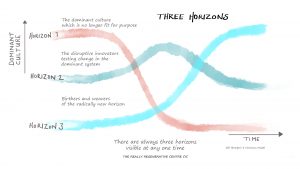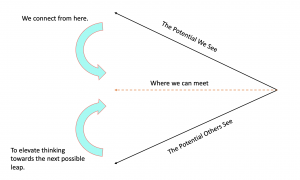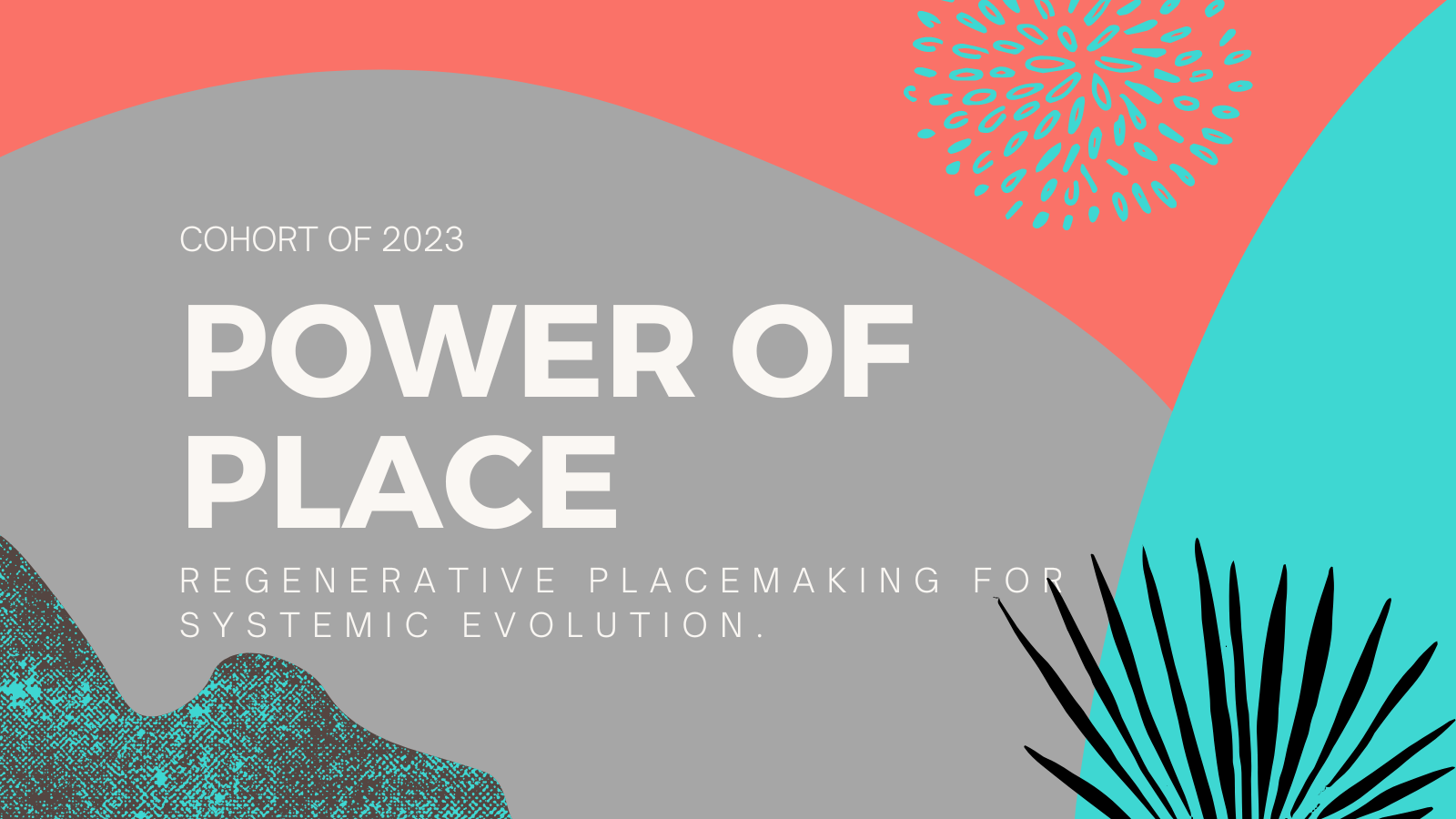I have been privileged to ask to join The RSA of which I am a Fellow in a regenerative learning inquiry this year. Our opening spark session included a q&a session. I’m always nervous about these because it essentially creates a position of ‘expert’ and ‘learners’ which isn’t really regenerative, so I wanted to be sure I responded in a regenerative way, trying to build capacity and have as generative a conversation as possible. Start as you mean to go on!
You can read about the first question I reflected on here. The second question was even harder.
How would you have a regenerative conversation with Rishi Sunak? What kind of approach would you use? How would you alter the language so as to make is more accessible or appealing?
I have to confess I lost my regenerative centre with this question and it’s only now I have a more regenerative response. Isn’t it often the case? After the fact when you’re put on the spot you think ‘damn, I wish I had said this….’. But luckily there’s the chance of a blogpost or youtube video as a follow up.
I made an attempt to think about it in a couple of different ways.
- How do we engage government in regenerative work?
- Or how do we engage government regeneratively?
- And – How do we engage with someone or an organisation or an entity that may have a very different view of how the world works?
Let’s start with the last one first. This is a pertinent question for all of us. In any room, in any gathering, there will be many different mindsets represented. There are also many different cultures, many different life experiences and many different personalities. But that is the subject of another post. In addition, any single individual can flow in and out of different mindsets depending on how well they manage their own personal state or how easily they are triggered.
Here two frameworks are helpful. Bill Reed’s Three Horizons and J G Bennet’s crocodile of potential (note he didn’t call it that, I did).

The Three Horizons framework posits that at any point in time in human history, three horizons are available to us. The dominant culture (how things are done around her now), the disruptive horizon (people who recognise that the dominant culture has reached its height and is no longer fit for purpose and are trying to do something about it) and the third horizon (the new and emergent future that is the next evolutionary leap).
It seems to me that there is also another underlying question that is related to those above. Where, as regenerative practitioners with a clear desire to support a transition to a regenerative world, do we put our energies?
- Do I put my energy into bringing the potential of the third horizon into view for the dominant culture of the day (that might be working with corporations, governments, media – whatever is the power structure of the dominant culture)?
- Do I put my energy into helping people already in the disruptive horizon to create innovations that enable the third horizon to be born and avoid being captured by culture-as-usual?
- Do I put my energy into birthing the new horizon?
- Or do I try to work in one or more concurrently?
Again let’s make it real. Let’s take food systems as an example. Do you work with existing global food organisations to see how they might change or alter their impact on the future viability of food systems? Do you work in the field of innovation where new possibilities are opening up through alternative proteins, synthetic foods, different business models such as B Corps can create change? Or do you support the transformation of food systems from global to glo-cal by exploring, support the growth of agroecology and regenerative agriculture or look at how AI could redesign the global food system without impact on planetary boundaries and human health?
If we think about politics the questions might look like this. How do I engage with existing political system to introduce the potential of regenerative thinking and design into the current system? How do I engage with groups who are trying to change or disrupt the existing system – whether they are groups inside existing political parties, activist agitators, think tanks or through supporting processes like citizens assemblies that shift power and decision making? How do I support the emergence of a new form of politics commensurate with the catastrophic risk of the 21st century that has the capacity to regenerative life?
When considering the question about whether or not to adapt our language and approach to better connect with people or organisations we perceive to have a different mindset than our own, in many ways we are considering a similar underlying question. Where should I put my energies and how?
But the presenting questions might be: do we engage from an embodied regenerative perspective using the language, behaviour and being of this paradigm which (we may perceive) risks putting them off completely or do we adapt our approach and language that the people we want to engage might more readily understand? In the hope that we can act like water through the cracks – even though this may risk compromising the integrity of the thinking?
Something else to consider might be; even by thinking of a group of people as having ‘different’ thinking to our own, are we perpetuating the story of separation that we so desperately need to heal? Are we bringing judgement with us? How helpful is it to be able to ‘diagnose’ people’s mindset?
A third question might be: does transformative change happen from the top down, bottom up, middle in or all three at once? And if it’s bottom up and side in, is it worth putting my energy into the dominant culture?
We’re back to the question of where and how.
What’s your cosmology?
A way to explore both these tracks of inquiry is to ask the question ‘what’s my theory of change?’ How do I really think change happens? Our own cosmology helps to shape our theories of change. There are hundreds if not thousands of theories of change out there. It might be cynical to say ‘yes, but where’s the change?’ or also a fair question!!

I’ve tested a lot, and this one works for me. It is a framework that Carol Sanford spoke about when I was in her CAD programme and it helped me to decide where I would put my own efforts for the time I have left and helped to inform how I might do that. What does it say?
Simply, the lower meets the higher in the middle. It’s a poor descriptor because it has hierarchy in the language, but this is where we often get stuck with a paucity of language. Perhaps a better description would be adding value from evolutionary potential to disruptive innovation and common existing thought?
It posits that you have to call to people from several levels beyond where they currently are to prompt transformative change. Let’s start with a historical analogy:
Example 1: J F Kennedy setting the intention of putting man on the moon. If he had said we’re going to send a rocket to Scotland, the lift in potential and capability of NASA would have been very different than it became.
Example 2: Long before I had ever heard of the regenerative paradigm I used to run a brand communications agency in London. Anyone in that field at the time will know that clients used to send a pitch brief to which you would respond – unpaid. An agency might offer up 3 approaches: one that answered the brief, a really transformative option and a middle way. What do you think was the most common result? Of course – the middle way. There are a lot of drivers behind that, but it’s another example of how such a framework works.
Example 3: In her brilliant book Indirect Work, Carol Sanford tells the story of coach . By setting a vision in front of his team that they could by their way of playing transform the opportunities and potential of whole communities, he lifted their potential as players beyond what they could achieve with mere performance coaching.
So if the higher brings the lower to the middle, what’s the implication of that in answering the above question?
A little bit more on ‘making regenerative more accessible’.
This always makes me smile because for years I have been asking the same question of all my mentors in the regenerative field. Why do we use such obfuscating language that requires the kind of mental gymnastics that make my brain fry and give me a migraine? For so many years I felt I had to ‘translate’ it. I still do to a large degree. But the more and more I work with regenerative technology – especially frameworks – I’ve come to a different conclusion and an approach which may not be pure but it works for me.
First a quick look at making things accessible through adaptation or interpretation.
What might taking the adaptive approach require? What, if any, are the risks that ‘making regenerative more accessible’ will dilute the potential and power of the work?
What might we chose if we are to stay in integrity with a regenerative paradigm or energy? I have found that a better way to work might be instead of ‘accessible’ to think of it as being ‘applicable’.
To make what is regenerative applicable to anyone – whatever their mindset – I work with storytelling, parable and inquiry which helps to shape an image of the regenerative future and tries generate an irresistible energy field to which anyone on different horizons be attracted and with which they can engage. I find if I can work with story the mindset of the individual or organisation it doesn’t matter. I also have to couple that with letting go of any expectation of outcome. If I am attached to the end result – i.e. I have to change Rishi’s mind, I will simply be pulled back into persuasive argument. At the heart of persuasive argument is an underlying belief that I can change minds through rational argument, applying forces and behavioural change tactics. Those beliefs do not stem from a regenerative mindset.
So back to governments. If I were in policy work, I might try to shape and get funded as many inquiries as I could that have regenerative and evolutionary potential at their heart which would act as an attractor and educator, shining a light on what might be possible in an economy and culture that are about creating the conditions conducive to life. That is calling from the higher to bring the lower toward the middle.
My aim is to shift thinking across a level, because nothing in developmental research that I have seen suggests that we can leapfrog developmental levels – rather than we do have to progress through them. I am totally open to challenge on that if anyone has any examples they can share.
My process for decision-making.
How did I arrive at my own decisions about how and where I would work in the world? It’s been interesting to reflect on that. I think I do two things:-
- I look for patterns and processes; if they repeat often enough through many different facets of life, I know something works. There were already enough examples of the higher meets the lower to reach the middle in my experience to have some faith in it.
- If I can’t see any patterns or processes that repeat, I work with a decision-making framework for complexity I first encountered through the irrespressible Dave Snowdon of Cynefin. Probe Sense Respond. Safe fail experiment not fail safe design. If an experiment succeeds, I amplify it. If it doesn’t, I dampen it. It allows for novel or emergent practice.
II’ve done a lot of experiments with this framework as a theory of change, and every time it has worked so I trust it. Even so I am still tempted often down the adapting / water-through-cracks approach just because it’s easier, more palatable, I can get paid to work that way, and it still feels like something can be changed but in my heart I know it’s not transformative change. So it’s a compromise and a triumph of hope over experience.
If working with frameworks for sensemaking appeals to you, this is one of the core foundations of our online learning journey Power of Place. It’s not too late to join our 2023 cohort – we start on February 24th. You can find out more here.



Recent Comments